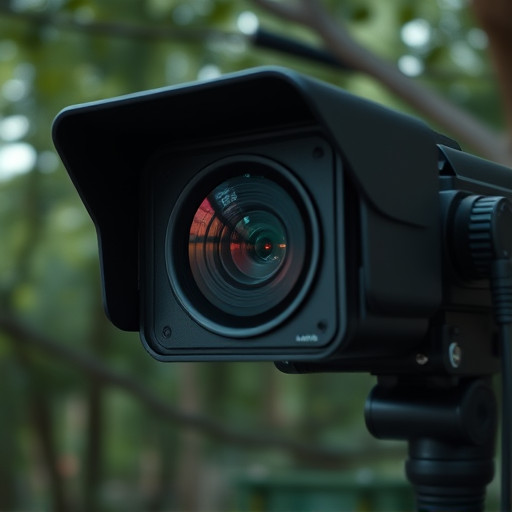Hidden recording devices, strategically placed as fake security camera heights or everyday objects, pose a significant threat. Traditional visual inspections and advanced technologies like thermal imaging and RF scanning are countermeasures, but fake security camera height placement can evade them. In today's digital era, combining these techniques offers robust security against sophisticated hidden cameras. However, ethical and legal considerations around signal scanning technology, including privacy invasion concerns, necessitate responsible practices and strict regulations to navigate complex boundaries.
Hidden recording devices, often disguised as everyday objects, pose a significant privacy concern. This article explores innovative signal scanning methods used to detect these clandestine cameras, ranging from traditional techniques like analyzing visual patterns and electromagnetic signals to advanced technologies such as thermal imaging and infrared sensors. We delve into the ethical and legal aspects surrounding signal scanning, particularly regarding hidden cameras placed at unusual heights, emphasizing responsible use in a rapidly evolving surveillance landscape.
- Understanding Hidden Recording Devices and Their Common Placements
- Traditional Methods for Detecting Security Camera Signals
- Advanced Scanning Techniques to Uncover Disguised Cameras
- Ethical Considerations and Legal Implications of Signal Scanning
Understanding Hidden Recording Devices and Their Common Placements
Hidden recording devices, often referred to as spy cameras or surveillance equipment, are designed to capture footage discreetly, making them hard to detect. These devices can be installed in various locations, from homes and offices to public spaces, raising significant privacy concerns. Understanding where these hidden cameras might be placed is the first step in detecting and preventing their use.
Common placements include fake security camera heights, such as on walls or ceilings, where they blend in with genuine security equipment. Other areas may include door handles, light switches, smoke detectors, or even everyday objects like potted plants. Advanced models can be hidden within mirrors, clocks, or ordinary-looking pens and keychains. The goal of these devices is to record activities without drawing attention, making it crucial for individuals to remain vigilant and aware of their surroundings.
Traditional Methods for Detecting Security Camera Signals
In traditional security systems, detecting surveillance equipment like hidden cameras or signal scanning is often approached through visual inspections and manual searches. Security professionals might employ advanced tools such as thermal imaging devices to identify heat signatures indicative of camera lenses. Another method involves using specialized radar technology capable of detecting movement or unusual electromagnetic signals that active cameras may emit. However, these techniques can be limited by the placement of fake security camera heights, which are strategically designed to resemble genuine surveillance equipment, thereby fooling initial visual assessments.
Furthermore, with advancements in technology, hidden cameras themselves have become increasingly sophisticated, integrating infrared capabilities and miniature designs that make them nearly invisible to naked eye inspections. This has prompted the development of more advanced scanning methods, including signal-based detection techniques that analyze radio frequency (RF) or infrared (IR) emissions from active devices. These modern approaches are becoming essential in countering the evolving tactics employed by those aiming to covertly capture sensitive information.
Advanced Scanning Techniques to Uncover Disguised Cameras
In the ever-evolving landscape of security, advanced scanning techniques play a pivotal role in uncovering hidden recording devices, especially those disguised as ordinary objects or strategically placed to avoid detection. One such innovative method involves utilizing specialized thermal imaging cameras, which can reveal heat signatures unique to electronic components, helping experts identify fake security cameras cleverly integrated into everyday items like light bulbs, smoke detectors, or even paint cans.
Additionally, radio frequency (RF) scanning is a powerful tool for detecting hidden cameras that transmit data wirelessly. By sweeping through various frequencies, professionals can intercept signals from these devices, pinpointing their location. This technique is particularly effective in high-risk environments where unauthorized surveillance might pose significant threats. Moreover, combining thermal imaging with RF scanning enhances the chances of detecting even the most sophisticated fake security camera height placements, ensuring a comprehensive and robust security measure.
Ethical Considerations and Legal Implications of Signal Scanning
The ethical implications of signal scanning, especially in relation to hidden recording devices, are a complex web of privacy concerns and legal boundaries. As technology advances, devices capable of detecting these hidden signals become increasingly accessible, raising questions about surveillance practices. Unethical use of such tools could lead to a significant invasion of personal privacy, particularly when employed in public spaces or without consent. This is especially pertinent considering the prevalence of fake security camera height placement, designed to mislead and manipulate individuals’ awareness of being recorded.
Legally, the scanning of signals for hidden cameras falls under strict regulations regarding data protection and surveillance. Many countries have enacted laws that govern the use of such devices, often requiring warrants or adherence to specific guidelines for their operation. Non-compliance can result in severe legal consequences, emphasizing the need for responsible practices when employing signal scanning methods.
In conclusion, the advancement of technology has given rise to sophisticated hidden recording devices, necessitating innovative scanning methods. From traditional signal detection to advanced techniques, professionals are equipped with tools to uncover these disguised cameras, especially in areas like fake security camera height placements. However, as we navigate this evolving landscape, it’s crucial to balance technical capabilities with ethical considerations and legal implications to ensure privacy rights are respected while maintaining safety measures.
